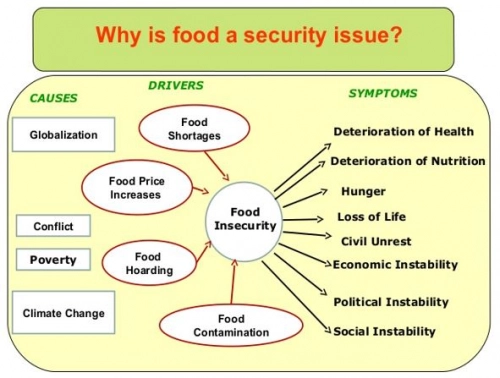Martinzaanana87
Computer Scientist : Computer Scientist
Wants to meet Just Friends
Articles
16
Followers
6
profile/554520210325_163311.jpg.webp
Martinzaanana87

Food Security Key To Development
~2.1 mins read
Food security “exists when all people, at all times, have physical, social and economic access to sufficient safe and nutritious food that meets their dietary needs and food preferences for an active and healthy life.” – FAO, 1996
The core concept of food security carries the access to healthy food and optimal nutrition for all.
Household food security is the application of this concept to the family level, with individuals within households as the focus of concern.
Food insecurity refers to a lack of access to enough good, healthy, and culturally appropriate food.
Characteristics of being Food Secured:
Concept of food security also includes the presence of following characteristics:
Enough food: If there is adequate food as per one’s need and requirements.
Good food: It should be with desirable taste, texture and other attributes.
Healthy food: It should be nutritious and sustaining with proper vitamins, minerals, fibre, energy, and all the other things that our bodies need.
Culturally appropriate food: Having access to culturally appropriate food means that people have food that they are familiar and comfortable with including availability of familiar foods & varieties.
Pillars of Food security:
Basically, there are four pillars/components of food Security. They are:
Food availability:
Having sufficient quantity of appropriate food available.
It includes: domestic production, import capacity, food stocks, food aid.
Accessibility:
Physical and economic access to food
Purchasing power, income of population, transport and market infrastructure
Utilization:
It includes adequate dietary intake and ability to use nutrients in the body.
Food safety, hygiene and manufacturing practices applied in primary agricultural production, harvesting and storage; food processing; transportation, retail, households, diet quality and diversity: meeting needs in terms of energy, macro- and micronutrients.
Stability:
Stability of supply and access
Weather variability, price fluctuations, political factors, economic factors
Dimensions of food security and its determinants:
Availability Accessibility Utilization Stability
· Domestic production
· Import capacity
· Food stocks
· Food aid
· Income, purchasing power, own production
· Transport and market infrastructure
· Food distribution
· Food safety and quality
· Clean water
· Health and sanitation
· Care, feeding and health seeking practices
· Weather variability, seasonality
· Price fluctuations
· Political factors
· Economic factors
Source: FAO
Factors affecting Food Security
profile/554520210325_163311.jpg.webp
Martinzaanana87

Monitoring And Evaluation
~2.2 mins read
DEFINITIONS OF MONITORING AND EVALUATION
There are two distinct but closely connected levels at which monitoring and evaluation take place:
• Programmes and projects that help generate the outputs contributing to the achievement of outcomes.
• Outcomes that represent the development changes intended to emerge from organization’s efforts, including through the production of outputs and the related contributions of partners.
Throughout the book, specific approaches, techniques and tools for monitoring and evaluation are presented that need to be applied at each of these levels. Traditionally staff was more familiar with programme- and project-based monitoring and evaluation. With results-based management, however, the challenge is to go beyond monitoring and evaluation of programme and project performance – in terms of the production of outputs – to linking such performance with rigorous and credible assessments of progress towards and achievement of outcomes. See Figure 2 below for how outputs and outcomes inter-relate along the “results chain.”
Regardless of the level at which monitoring and evaluation take place, common definitions of key concepts need to guide our actions.
• Monitoring – Monitoring is a continuing function that aims primarily to provide the management and main stakeholders of an ongoing intervention – be it of a project, programme or outcome nature – with early indications of progress, or lack thereof, in the achievement of results.
• Reporting, namely the systematic and timely provision of essential information at periodic intervals, is an integral part of the monitoring and evaluation function.
• Evaluation – Evaluation is a selective exercise that attempts to assess systematically and objectively progress towards and the achievement of an outcome (even project evaluations that assess relevance, performance and other criteria need to link to outcomes). In the context of results-based management, the outcome evaluation must increasingly be seen as an exercise rather than as a one-time event, involving assessments of differing scope and depth carried out at several points in time in response to evolving needs for evaluative knowledge and learning during the effort to achieve an outcome.
• Feedback – is a process within the framework of monitoring and evaluation by which information and knowledge are disseminated and used to assess overall progress toward results or confirm the achievement of results. Feedback may consist of findings, conclusions, recommendations and lessons from experience. It can be used to improve performance and as a basis for decision-making and the promotion of learning in an organization.
• Lessons learned – are learning from experience that is applicable to a general situation rather than to a specific circumstance. The extent to which stakeholders not only learn but also internalize their learning from evaluative knowledge is often a direct result of the extent to which they are involved in the evaluation process. This implies that the way in which an evaluation is conducted will impact upon the sustainability of the relevant results. Lesson learning also reveals best practices that serve to accumulate and apply knowledge about how and why certain interventions or strategies work in different situations and contexts. Documentation of lessons learned and best practices is essential.
Advertisement

Link socials
Matches
Loading...
